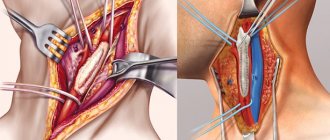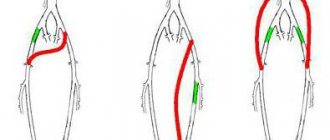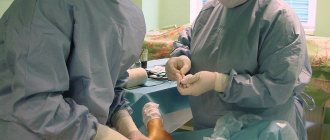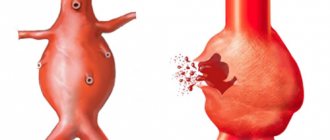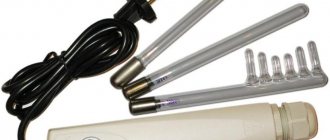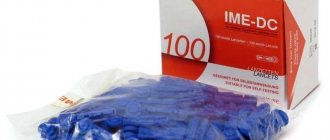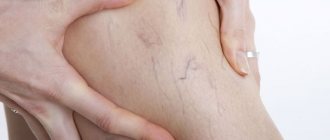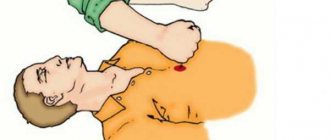Thrombectomy of a hemorrhoid is the removal of a venous blood clot (thrombus) that has filled its cavity. It is used in the absence of a positive result from conservative therapy. This is a way to treat external or prolapsed internal cones. Refers to minimally invasive surgical methods. To remove thrombosis of a hemorrhoid, hospitalization in a hospital is not necessary. The procedure is carried out in an outpatient setting. No special long-term preparation is required.
According to statistics, 80% of cases of thrombosis are a complication of a long-term chronic course of the pathology. In rare cases, it occurs acutely. Regardless of the causes of formation, urgent evacuation of thrombosed hemorrhoids is necessary, since the condition can result in acute paraproctitis and sepsis.
Briefly about the main thing
Thrombectomy is a minimally invasive (low-traumatic) operation that is performed to eliminate a blood clot formed in hemorrhoids.
This intervention is performed for acute hemorrhoids. Thrombectomy is performed under local anesthesia and takes no more than 10 minutes . The procedure has the shortest list of contraindications and does not require hospitalization of the patient. You can go home immediately after surgery .
The recovery period passes quickly and is not associated with serious restrictions. It will be necessary to follow basic hygiene rules: wash the anal area with warm water after each bowel movement. You should also follow all the doctor’s recommendations: ___• follow a diet, ___• limit physical and nervous stress, ___• avoid excluding thermal procedures, ___• take prescribed medications, ___• carry out local treatment of the postoperative wound.
Causes of thrombosis of hemorrhoidal veins
Thrombosis can develop as a consequence of an acute, first-time attack of hemorrhoids, as well as as a complication of chronic hemorrhoids. The likelihood of developing thrombosis in chronic pathology increases with increasing “length” of the disease and the size of the nodes.
An attack can be triggered by: ___• chronic stool disorders (constipation, diarrhea, constipation alternating with diarrhea), ___• increased physical activity, ___• labor, ___• consumption of spicy food and/or alcohol, ___• hypothermia, overheating.
The development of acute hemorrhoids is promoted by all conditions accompanied by an increase in intra-abdominal pressure - from pregnancy to chronic cough and obesity.
Another factor in the occurrence of hemorrhoids is stagnation of blood in the veins of the pelvis, which often occurs as a result of a sedentary lifestyle and “sedentary” work.
Mechanism of blood clot formation
Thrombosis of external hemorrhoids occurs more often. It is extremely rare that the process spreads from external to internal nodes. Even less commonly, it occurs isolated in internal nodes.
Thrombosis of the external hemorrhoid occurs in both acute and chronic processes. In both cases, the pathology develops as a result of a combination of three factors: ___• slowing blood flow in the node, ___• blood thickening, ___• damage to the vascular network of the hemorrhoid.
Signs of thrombosis
___• The main symptom of thrombosis is acute, excruciating pain that prevents normal bowel movements. The pain syndrome intensifies many times over with straining, movement, and also in a sitting position. In severe cases, the pain takes on a pulsating character and, depending on the location of the node, can radiate to the leg, inside the rectum or to the external genitalia. ___• Bleeding often occurs, which varies in intensity - from individual drops on the surface of the stool to a trickle of blood during bowel movements. ___• Thrombosis of the internal node causes the sensation of a foreign body inside the rectum. Since the bleeding injured node comes into contact with feces, a secondary infection may occur. In such cases, mucous or purulent discharge appears and body temperature rises.
Thrombectomy in preventing stroke
As a result of thrombosis and blockage of the arteries supplying the brain, an ischemic stroke develops. A glucose deficiency is created in the brain tissue and hypoxia occurs, which is clinically manifested by various neurological disorders. Patients develop weakness, paralysis of arms or legs, speech and visual dysfunction, and disorientation in space.
a blood clot, located in the arteries supplying blood to the brain, can cause blood flow disturbances that threaten ischemic stroke
Timely removal of a blood clot using a catheter helps prevent acute disruption of cerebral blood supply and save the lives of patients. Computed angiography allows you to accurately determine the location of the thrombus, assess the degree of damage to brain tissue during thrombectomy, and predict the results of the operation.
The operation is performed under general anesthesia. A catheter containing a stent is inserted through the femoral artery in the groin, captures the clot with it, and removes it through a micro-incision in the artery. If thrombectomy is not possible due to the particular location of the clot, thrombolysis is used.
Urgent surgery can prevent the severe consequences of an ischemic stroke and save a person’s life.
When is thrombectomy necessary?
Indications for surgery
Most cases of acute thrombosis of hemorrhoids (uncomplicated thrombosis, small size of the node) respond well to treatment with conservative methods. The main thing is to consult a doctor in a timely manner.
Surgical procedures are performed if the period from the onset of the disease is 48-72 hours. If more time has passed since the onset of thrombosis, the doctor prescribes conservative treatment followed by surgical treatment. Surgical removal of a thrombosed node is carried out at a later stage from the onset of the disease in the following cases : ___• conservative therapy was unsuccessful, ___• acute pain syndrome, poorly controlled by standard painkillers, ___• symptoms of intoxication (general weakness, fever, headache), ___ • contraindications to the use of thrombolytic agents (pregnancy, lactation), ___• large size of the hemorrhoid.
The decision on surgical intervention is made by the doctor after an examination, which will reveal contraindications to surgery. Another goal of diagnostic manipulations is the choice of surgical intervention method.
Indications
Thrombectomy is indicated for patients with thrombosis or embolism of large vessels. Disturbed blood composition and vascular stenosis are the root cause of thrombus formation. With an increased content of platelets in the blood, primary thrombosis develops, and if the vessel wall is damaged, secondary thrombosis develops.
elimination of vascular thrombosis of various localizations is the goal of thrombectomy
Indications for the operation:
- External hemorrhoids complicated by thrombosis of the hemorrhoid;
- Lack of effect from conservative therapy with thrombolytics;
- Severe intoxication and sharp jerking pain;
- The patient's serious condition;
- Progression of the underlying disease;
- Pregnancy;
- Traumatic phlebothrombosis;
- Thrombophlebitis;
- Floating blood clots;
- Blue phlegmasia in the absence of gangrene of the limb;
- Threat of developing necrosis of hemorrhoidal tissue;
- TELA.
Conservative treatment of thrombosis lasts on average from 2 to 4 weeks. It is not always effective. The main indication for surgery is the desire of the patient and the doctor to get a quick and expected result.
Operation is contraindicated:
- Persons with severe concomitant diseases,
- Patients with signs of sepsis,
- Exhausted sick
- For persons who will not tolerate anticoagulation therapy after surgery,
- Patients with malignant tumors or gangrene of the limb,
- Women with a difficult pregnancy, complicated by gestosis, anemia, exhaustion,
- Persons with postthrombophlebitis syndrome,
- Patients who developed thrombosis after irradiation.
Types of operations
Removal of a blood clot for external hemorrhoids
Removing a blood clot for external hemorrhoids is a simple operation that lasts only a few minutes. The doctor makes a small incision over the blood clot. Then the blood clot is removed with tweezers or a clamp; the wound is not sutured. The inflammatory edema subsides almost immediately, the pain subsides, and the patient’s general condition improves.
According to indications, a more complex operation can be performed - excision of an external hemorrhoid with blood clots , which is also performed under local anesthesia and does not require the patient to be hospitalized. During excision, the pathological element is removed, which reduces the risk of recurrent thrombosis.
Removal of a blood clot for internal hemorrhoids
Thrombosis of internal hemorrhoids is much less common and, as a rule, develops in the later stages of the development of the process (III-IV stages of hemorrhoids).
Treatment in this case is conservative. After stopping the acute process, treatment is carried out aimed at removing internal hemorrhoids (hemorrhoidectomy).
Surgery to remove a blood clot from a leg vein
This serious disease is manifested by pain in the muscles of the lower leg, which intensifies in a standing position and when they are lightly compressed with the palm of the hand.
The disease often causes pulmonary embolism. Due to the large lumen of the leading veins of the extremities, large embolic blood clots form in them. When the leg muscles contract, they are squeezed out of the leg veins and become life-threatening to the patient. Intense blood flow ensures their easy separation and blockage of the pulmonary artery. Floating or floating thrombi, which have a single point of fixation in the vessel, deserve special attention. Most of the clot is located freely and does not bind to the walls of the vein. Such a thrombus is the most dangerous for the patient, since it can easily break off and migrate to the pulmonary artery.
an important indication for removing a blood clot from a limb (along with an acute condition) is the risk of thrombus embolism entering the bloodstream and a high probability of subsequent blockage of vital pulmonary vessels
Pain in the calf muscles is usually accompanied by a feeling of fullness, local hyperthermia and swelling of the legs. After some time, the skin becomes cyanotic, and the venous plexuses are visible through it. In some patients, the knee joint becomes inflamed, it hurts and swells, and its contours become smooth.
Treatment of deep vein thrombosis of the legs is aimed at restoring blood flow and preventing pulmonary embolism. Patients are hospitalized in the vascular surgery department, where surgery is performed and the condition of the patients is monitored in the early postoperative period.
removing a blood clot from a vein
Thrombectomy for thrombosis of the veins of the lower extremities is performed under endotracheal anesthesia. The femoral vein is isolated on the affected limb, an incision is made in the projection of the existing thrombus, and a balloon catheter is inserted into the incision, inflating it. When the catheter is removed, blood clots are released along with it, retrograde blood flow is created, and a heparin solution is injected into the vein.
To maintain the integrity of the venous valves and remove blood clots from the main veins of the legs, a special catheter with two inflated balloons is used. After removing the blood clots in the leg, the vessel is sutured. The limb is elastically bandaged on the operating table. Thrombectomy allows the patient to forget about the existing problem within a few days and completely return to an active lifestyle.
After thrombectomy of the lower extremities, conservative treatment is carried out. Patients are prescribed:
- "Heparin"
- "Reopoliglyukin"
- "Pentoxifylline."
On days 3-4 after surgery, patients are allowed to walk using an elastic bandage or compression stockings.
Compression therapy has gained worldwide acceptance. The limb is bandaged evenly, starting from the base of the toes. Each subsequent round of bandage is applied to the previous one, covering it to the middle. The foot, heel and lower leg are completely covered with a bandage. If it is tightened, venous blood flow will be disrupted and pain will occur. The elastic bandage is designed to increase the speed of blood flow, develop venous collaterals and prevent secondary varicose veins of the saphenous veins.
If blood flow remains poor after thrombectomy or thrombosis has not been completely eliminated, phlebectomy of the superficial femoral vein is performed.
Diagnostics
Diagnosis of hemorrhoidal thrombosis is not difficult. The diagnosis is made by external examination of the anal area .
If the proctologist decides on surgical intervention, it will be necessary to take tests : ___• general blood test, ___• coagulogram, ___• blood glucose level.
It is necessary to tell the attending surgeon about all medications taken, since some medications (oral contraceptives, non-steroidal anti-inflammatory drugs, etc.) affect blood clotting.
Technique for performing thrombectomy for hemorrhoids
Thrombectomy of a hemorrhoid is performed on an outpatient basis and only in severe cases is the patient hospitalized in a surgical hospital.
The surgical intervention is performed under local anesthesia; for this purpose, an anesthetic is injected into the thrombosed lump and the tissue around it, the effect of which occurs instantly. Then the surgeon dissects the hemorrhoidal vein and removes the blood clot from it, after which he places sutures on the wall of the node. The suture heals within 3-5 days.
Such an operation with an experienced doctor lasts no more than ten minutes. Patients feel relief literally immediately after surgery. In addition, after thrombectomy, the patient does not require any special restorative measures, so he can lead a normal lifestyle.
Before the suture heals, the patient should wash himself with warm water without soap or a weak solution of potassium permanganate and change the gauze bandage after each visit to the restroom “in a big way.”
You can also speed up the healing of the seam using methyluracil suppositories or ointment.
Contraindications
___• The operation is not performed if the patient’s condition is extremely serious (general exhaustion, complications of cardiovascular diseases, sepsis). ___• Surgical interventions are not prescribed for severe pregnancy (severe anemia, poorly controlled early toxicosis with dehydration, late toxicosis with generalized edema, etc.).
Since thrombectomy is a minimally invasive (low-traumatic) operation, the procedure can be prescribed after the patient’s condition has been stabilized. The decision about surgery or its inadmissibility is made individually, taking into account all risk factors.
Recovery after a surgical procedure
Any operation to restore blood flow in sore legs lasts about two hours. When the surgical stage is completed, postoperative rehabilitation of the lower extremities begins.
Recommendations on the nature of rehabilitation therapy are made based on the complexity of the intervention performed and its success. As a rule, during the postoperative period, patients are prescribed gymnastics and compression wraps.
Gymnastics
Moderate physical activity does not harm recovery in the postoperative period, but promotes a faster recovery. When the surgical stage is completed, the patient is recommended to raise his legs above the bed or bend them while lying down.
You should avoid exercises where there is a static component. Motor rehabilitation is carried out after applying elastic compression.
A light massage of the lower legs is allowed.
A gradual increase in loads helps improve venous blood flow in thrombophlebitis. At the beginning of the postoperative period, a daily one and a half hour walk is enough. Minor pain or cramps are considered a normal reaction of the limbs, but the absence of such phenomena is the basis for increasing the intensity of the load.
After 2 - 3 months, the postoperative course is supplemented with intensive gymnastics - exercises such as “scissors” or “bicycle”. During this period, you can exercise on an exercise bike or treadmill, skiing, or swimming. Options for other types of postoperative exercises can be found in videos published on the Internet.
Compression
Elastic compression helps improve phlebohemodynamic parameters in people diagnosed with thrombophlebitis. Elastic bandages of limited elongation or special compression knitwear are used. Elastic compression is used for 2–3 months of the postoperative period.
Each surgical method has its own characteristics, so treatment and rehabilitation are always selected individually. Thrombophlebitis will not return after surgery if the patient follows the doctor’s recommendations, adheres to an activity regimen, and also avoids stress that can cause destruction of the postoperative suture.
Preparation for the procedure
If the doctor decides to undergo thrombectomy, the patient is prescribed a diet that excludes foods that cause gas formation in the large intestine (cabbage, legumes, fresh fruits and juices from them). The ban also includes products that cause a rush of blood to the rectum and/or have an irritating effect on the mucous membrane (smoked meats, spicy foods, alcohol).
Immediately before the procedure (in the morning and evening before the operation), you will need to cleanse the intestines using a Microlax microenema.
Preparation for thrombectomy is carried out when the patient's condition allows it. In case of severe pain and an impressive size of the node, bowel cleansing is not performed, and in the event of a threat of severe complications, surgical removal of the blood clot is carried out on an emergency basis.
Cost of surgery in different cities of Russia
The thrombectomy procedure is simple, safe, accessible and inexpensive compared to other intestinal surgeries. In Russia, the cost of manipulation on one node ranges from 3 to 5 thousand rubles. The price varies significantly depending on the severity of the thrombosis and the region of the country where the procedure is performed. In various Moscow clinics it is the highest and starts from 5 to 9 thousand rubles. Depends on the status of the medical institution and the qualifications of specialists. In other regions, the cost of manipulation varies:
- St. Petersburg - 3,000.
- Kazan - 3,500.
- Tula - 1,100 rubles.
In public medical institutions, the procedure is performed free of charge according to indications if you have a compulsory medical insurance policy.
Hemorrhoids do not heal on their own. According to the Russian Ministry of Health, after 2-4 years, in the absence of treatment and compliance with certain rules of life, malignancy occurs and rectal cancer develops. Treatment costs will have a different order of magnitude. To avoid severe complications and long-term treatment, it is necessary to contact a specialist in time and treat the disease as planned, and not urgently.
How is the operation performed?
The procedure can be performed in a gynecological-style chair or on a couch and takes a few minutes. First, doctors give an anesthetic injection that “freezes” the tissue, just like in a dentist’s office. Therefore, the patient is conscious, but does not feel pain.
The surgical intervention takes several minutes and involves three manipulations: ___• opening the affected node (small incision), ___• removing the blood clot, ___• stopping the bleeding (the wound can be sutured, but more often it is not sutured)
After the procedure you can go home.
The exception is those cases of thrombosis when severe complications occur (gangrene of the node, paraproctitis, severe bleeding) that require hospitalization.
Thrombectomy of hemorrhoids is the main method of treating acute thrombosed hemorrhoids
As we have already said, this complication requires immediate treatment, which can be carried out with medications or surgery.
Drug therapy for node thrombosis is aimed at eliminating inflammation in the tissues, alleviating the symptoms of the disease and eliminating the blood clot. For this purpose, they mainly use local medications, that is, ointments, rectal suppositories, creams and gels. Systemic drugs with a thrombolytic effect may also be prescribed.
If conservative therapy is ineffective, they resort to surgical treatment - node thrombectomy.
Nodal thrombectomy is a minimally invasive surgical procedure, the essence of which is to remove a blood clot from the thrombus cavity. This method is symptomatic and does not affect the cause of thrombosis, that is, hemorrhoids.
Indications
Thrombectomy of nodes cannot be avoided in the following cases:
- thrombosis in acute external hemorrhoids;
- ineffectiveness of drug therapy;
- necrosis of hemorrhoids;
- severe pain that cannot be controlled with medications;
- contraindications to the use of medications (gestation, lactation and other conditions).
Thrombectomy is also performed when the patient insists on surgery in order to quickly alleviate the condition.
Contraindications
Since hemorrhoid thrombectomy is a minimally invasive surgical procedure and is performed under local anesthesia, this operation has a small number of limitations and contraindications.
But, nevertheless, this method of treating anorectal thrombosis is contraindicated in patients with the following complications:
- acute paraproctitis in the infiltration stage;
- acute paraproctitis in the abscess stage;
- inflammation of the rectum;
- lesions of the skin of the anal area of an infectious nature;
- severe exhaustion of the patient;
- sepsis.
Rules of behavior in the postoperative period
If the evacuation of hemorrhoidal blood clots was carried out against the background of the patient’s satisfactory condition, then the postoperative period does not provide for significant restrictions.
The following are prohibited: ___• physical activity, ___• thermal procedures (bath, sauna, beach holiday), ___• prolonged stay in a sitting or squatting position.
Products that cause a rush of blood to the pelvic vessels or irritation of the mucous membrane are excluded from the diet: spicy, salty, smoked foods and alcohol.
Food should be rich in fiber, which stimulates intestinal function (prunes, apples). It is not recommended to eat foods that can cause constipation (rice and semolina porridge, potatoes, pasta). If stool retention occurs, a mild laxative (for example, Forlax) is prescribed.
After each bowel movement, wash the anal area with warm water and change the sterile napkin. If suspicious symptoms appear (pain, bleeding, discharge from the wound), you should immediately consult a doctor.
Rehabilitation period
After thrombectomy of the lower extremities, regardless of the method performed, the patient must adhere to medical instructions, which will shorten the recovery process and reduce the risk of relapse of the disease. These include the following:
- If pain persists, analgesics can be taken in recommended doses.
- To prevent inflammation of a blood clot in the leg, a course of non-steroidal anti-inflammatory drugs is prescribed.
- To thin the blood, it is necessary to take anticoagulants and antiplatelet agents.
- In accordance with the doctor’s recommendation, the period of wearing compression garments is determined.
- To prevent the recurrence of a blood clot on the leg, you should avoid any degree of physical activity (even long walks) for a selected period, stop drinking alcohol and tobacco, and follow a diet.
- Do not carry out hygienic and cosmetic procedures that involve heating the skin (sauna, steam bath, hot bath, thermal wraps, etc.).
The rehabilitation period is assigned individually, so after removal it is important to regularly visit a specialist to monitor and evaluate the positive dynamics.
Reviews from patients and recommendations from doctors
We analyzed online reviews of patients who underwent removal of hemorrhoidal thrombosis. The vast majority of patients were satisfied with the procedure. The most common impression: “The procedure itself is not as unpleasant as waiting for it.”
No reviews of complications of the operation were found. The most common complaint is pain in the area of the postoperative suture, which disappears after a few hours, but may reappear during bowel movements.
A more serious drawback is the likelihood of relapse. In order to avoid recurrent thrombosis, you must follow all the recommendations of your doctor.
Pros and cons of the operation
The undeniable advantages of thrombectomy include:
- Speed – the operation takes no more than 15 minutes.
- Elimination of pain syndrome.
- Low level of trauma.
- Restoring normal blood circulation in the previously affected area.
- Short rehabilitation period - the patient can return to their normal lifestyle in about 2 days.
The disadvantage of the operation is the possibility of relapses.
Attention! Thrombectomy eliminates the blood clot, but does not relieve the patient of hemorrhoids. To avoid the development of further complications, this disease should be treated.
Advantages and disadvantages of the method
Thrombectomy is a low-traumatic method of treating acute thrombosis of hemorrhoids, which has both advantages and disadvantages. The method involves surgical intervention, so it is prescribed if conservative methods are contraindicated or ineffective.
Positive aspects of thrombectomy: ___• a short list of contraindications, ___• does not require hospitalization, ___• the shortest recovery period with a minimum number of restrictions, ___• minor side effects of the operation (pain, weakness, swelling), ___• complications are extremely rare.
Disadvantages of the method. Thrombectomy does not involve removal of the hemorrhoid, so recurrent thrombosis may develop. For this reason, in case of recurrent thrombosis, a more radical operation to remove thrombosed nodes (hemorrhoidectomy) is indicated.
Possible complications
- Rupture of the inner wall of the artery with its dissection and secondary thrombosis
- Tearing off the probe head and leaving it in the lumen of the artery
- Perforation of an altered artery wall with a probe with internal bleeding
- Complications associated with access (hematoma, lymph accumulation, wound suppuration)
Such complications are quite rare. Their frequency decreases as clinical experience with thrombectomies accumulates. In our clinic, we have not observed such complications over the past five years.
- Dissection of the arterial wall due to rough passage of the probe
- Transfer of pieces of blood clots to small arteries below the site of thrombosis
- Formation of hematoma along the artery
Such complications are usually identified during the operation and are usually corrected immediately.
After the operation, the patient may bleed in the incision area for some time. If the bleeding does not stop, you should consult a doctor.
As already noted, if the wound is not treated thoroughly, a bacterial infection may occur. The incision site becomes red, swollen and painful. The formation of suppuration is possible, which requires immediate medical intervention.
Prevention of relapse
Basic principles of prevention
Thrombosis of the hemorrhoidal node occurs as a complication of hemorrhoids, therefore, prevention of relapse consists in preventing the occurrence of enlarged hemorrhoids.
Hemorrhoids are a disease with a hereditary predisposition. Therefore, if there has already been one attack, there is a high probability of relapse. However, the implementation of a negative scenario is possible in the presence of additional risk factors: ___• pregnancy, ___• taking hormonal drugs, ___• overweight, ___• constant diet violations: eating spicy and fatty foods, alcohol, ___• abuse of thermal procedures (bath and sauna) or regular hypothermia, ___• work involving prolonged sitting or heavy physical work.
Necessary precautions
Most often, acute thrombosis occurs as a consequence of prolonged bowel dysfunction (chronic constipation). Therefore, you need to achieve daily bowel movements with a diet rich in fiber.
It is advisable to refrain from physical and nervous overload, as well as from hypothermia and overheating of the lower half of the body. You should not abuse alcohol, as well as spicy, smoked and salty foods.
When working “sedentarily”, you need to take regular breaks, during which you should perform hemorrhoid-preventing exercises. Many chronic diseases can contribute to the development of hemorrhoids, so taking care of your health is a reliable prevention of thrombosis of hemorrhoids.
Dangerous for the development of hemorrhoids and obesity. With this pathology, intra-abdominal pressure increases, the rheological properties of the blood change, problems with stool arise, and hormonal levels are disrupted. Therefore, normal weight is not only beauty, but also health.
Causes of thrombosis of hemorrhoidal veins
The main cause of thrombosis of hemorrhoidal veins is an increase in intra-abdominal pressure for a variety of reasons: playing sports, working, climbing stairs, and so on. This becomes an impetus for thrombus formation under conditions of persistent deformation of the veins. Pathologically altered vessels cannot cope with the load and blood thickening is the body’s protective response to the situation. The provoking factors in this case are:
- genetic predisposition;
- bad habits;
- dyspepsia: constipation followed by diarrhea;
- low mobility;
- errors in diet (spicy foods);
- prolonged sitting or standing in a static position;
- hypothermia or overheating;
- chronic diseases of the pelvic organs;
- pregnancy.
Most often, thrombosis of external nodes occurs; internal hemorrhoids rarely thrombose, resulting from pinching of the cones by the anus.
Is it possible to do without surgery?
If doctors recommended thrombectomy of the hemorrhoid, this means that conservative therapy is not indicated in your case. You should not try to treat thrombosis with “traditional” methods.
If treatment is inadequate or absent, complications may develop: ___• bleeding, ___• gangrene of the node, ___• paraproctitis (purulent melting of peri-rectal fatty tissue).
In some cases, the affected node may open on its own and free itself from the blood clot. At the site of the “bump,” a fold of skin is formed – an anal fringe, which causes unpleasant sensations (itching, weeping) and is an unpleasant cosmetic defect.
